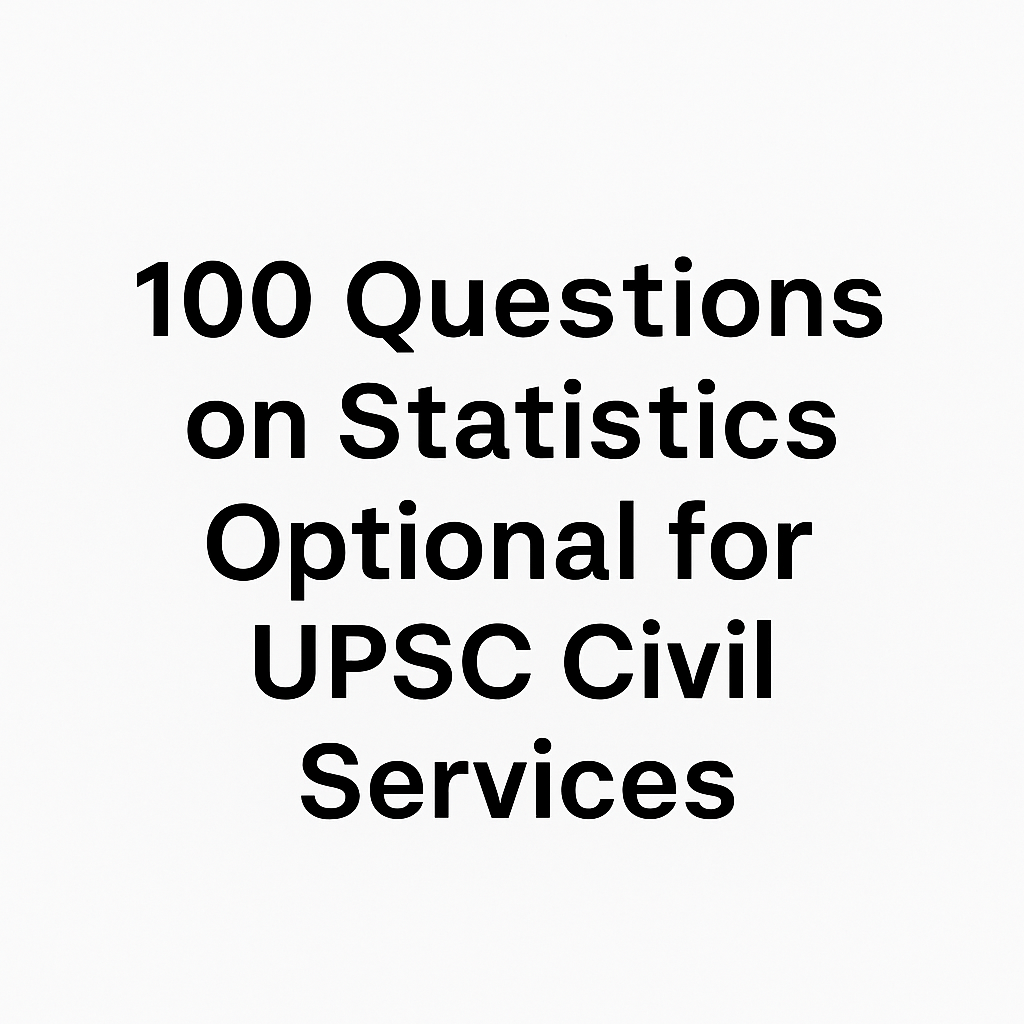Description
Statistics is one of the highly analytical optional subjects in the UPSC Civil Services Examination. It requires conceptual clarity, application of mathematical methods, and interpretation of real-life data. To help aspirants, we have compiled 100 practice questions based on the UPSC syllabus. The questions are divided into chapters for systematic preparation.
For UPSC Coaching , Join FIRST IAS INSTITUTE (India’s Top IAS Coaching)
Chapter 1: Probability Theory and Distribution
- Define probability and explain classical, relative frequency, and axiomatic approaches.
- State and prove Bayes’ theorem with applications.
- Differentiate between discrete and continuous random variables with examples.
- Derive the mean and variance of the Binomial distribution.
- Discuss the properties and applications of Poisson distribution.
- Derive the moment-generating function of Normal distribution.
- Explain the law of large numbers and its significance.
- State and explain Central Limit Theorem with proof.
- Define conditional probability with suitable illustrations.
- Compare and contrast Geometric and Negative Binomial distributions.
Chapter 2: Statistical Inference
- Define point estimation and discuss properties of a good estimator.
- Differentiate between biased and unbiased estimators with examples.
- Explain the method of moments with illustrations.
- Discuss the maximum likelihood estimation method.
- State and explain Cramér-Rao inequality.
- Differentiate between confidence interval and confidence level.
- Define and explain Type I and Type II errors.
- Derive the test statistic for Z-test of a population mean.
- Explain Student’s t-distribution and its applications.
- Discuss the properties and applications of Chi-square distribution.

3: Correlation and Regression
- Define correlation and explain Karl Pearson’s coefficient.
- Discuss the difference between correlation and regression.
- Explain rank correlation and derive Spearman’s rank correlation formula.
- Define regression and derive the regression equations.
- Explain partial and multiple correlation.
- What are residuals in regression analysis?
- Derive the coefficient of determination.
- Discuss assumptions and limitations of linear regression.
- Differentiate between simple and multiple regression.
- Explain multicollinearity and its impact on regression results.
Chapter 4: Sampling Theory
- Define population and sample with examples.
- Differentiate between probability and non-probability sampling methods.
- Explain stratified random sampling with merits and demerits.
- Discuss systematic sampling and its applications.
- Explain cluster sampling and its uses in surveys.
- Derive the standard error of mean for simple random sampling.
- Explain sampling distribution with examples.
- Define sample size and factors influencing it.
- Discuss the concept of sampling error and non-sampling error.
- Compare and contrast sampling and census methods.
Chapter 5: Design of Experiments and ANOVA
- Explain the principles of experimental design.
- Discuss completely randomized design (CRD).
- Explain randomized block design (RBD) with layout.
- Discuss Latin Square Design and its advantages.
- Define and explain factorial experiments.
- Explain Analysis of Variance (ANOVA) and its assumptions.
- Derive the F-test statistic for one-way ANOVA.
- Discuss two-way ANOVA with examples.
- Explain the concept of interaction in factorial experiments.
- Differentiate between fixed effect and random effect models.
6: Multivariate Analysis
- Explain principal component analysis (PCA) with applications.
- Define factor analysis and discuss its assumptions.
- Differentiate between R-mode and Q-mode factor analysis.
- Explain cluster analysis and its applications.
- Discuss discriminant analysis and its role in classification.
- Explain canonical correlation analysis.
- Define multivariate normal distribution.
- Discuss Hotelling’s T-square statistic.
- Explain multiple discriminant function analysis.
- Differentiate between exploratory and confirmatory factor analysis.
Chapter 7: Time Series and Forecasting
- Define time series and its components.
- Explain trend analysis using moving averages.
- Discuss least squares method for estimating trend.
- Explain seasonal variation and methods of measurement.
- Define cyclical variation with examples.
- Explain exponential smoothing method of forecasting.
- Differentiate between deterministic and stochastic trends.
- Discuss ARIMA models in time series forecasting.
- Explain autocorrelation function and correlogram.
- Define stationarity and its importance in time series analysis.

Chapter 8: Econometrics and Applied Statistics
- Define econometrics and its scope in statistics.
- Explain the concept of simultaneous equation models.
- Discuss heteroscedasticity and remedies to handle it.
- Explain autocorrelation in regression models.
- Define multicollinearity and its detection.
- Explain Ordinary Least Squares (OLS) assumptions.
- Differentiate between endogenous and exogenous variables.
- Explain the use of dummy variables in regression.
- Define and explain instrumental variables method.
- Discuss applications of econometrics in policy analysis.
9: Demography and Vital Statistics
- Define crude birth rate and crude death rate.
- Explain age-specific fertility rate.
- Discuss infant mortality rate and its significance.
- Explain life table and its components.
- Define net reproduction rate and gross reproduction rate.
- Differentiate between morbidity and mortality statistics.
- Discuss population projection methods.
- Define dependency ratio and its implications.
- Explain the stable population theory.
- Discuss sources of demographic data in India.
Chapter 10: Official Statistics and Applications
- Discuss the role of Central Statistical Office in India.
- Explain the importance of National Sample Survey Office.
- Discuss limitations of official statistics.
- Explain the role of census in policy-making.
- Define index numbers and their applications.
- Derive Laspeyres and Paasche price index formulae.
- Explain Fisher’s ideal index number.
- Discuss Consumer Price Index and Wholesale Price Index.
- Define Human Development Index and its components.
- Discuss the importance of statistics in governance and planning.
Conclusion
Statistics optional for UPSC requires strong conceptual clarity and rigorous practice. These 100 questions are designed to cover all chapters of the syllabus including probability, inference, regression, sampling, ANOVA, multivariate analysis, econometrics, demography, and official statistics. Regular practice of these questions will not only enhance problem-solving ability but also strengthen analytical writing skills needed for the exam.
For Answer Writing Techniques – Join FIRST IAS INSTITUTE

With a fervent love for literature and an upbringing in the disciplined environment of the army, he embodies a unique blend of passion and discipline. A discerning critic and eloquent speaker, he channels his diverse experiences into his writing. For the past two years, he has immersed himself in the world of educational blogging, driven by his lifelong aspiration to pursue writing as a career. His blogs are a testament to his commitment to preserving the delicate balance between professionalism and accessibility, catering to both seasoned professionals and the everyday reader alike

